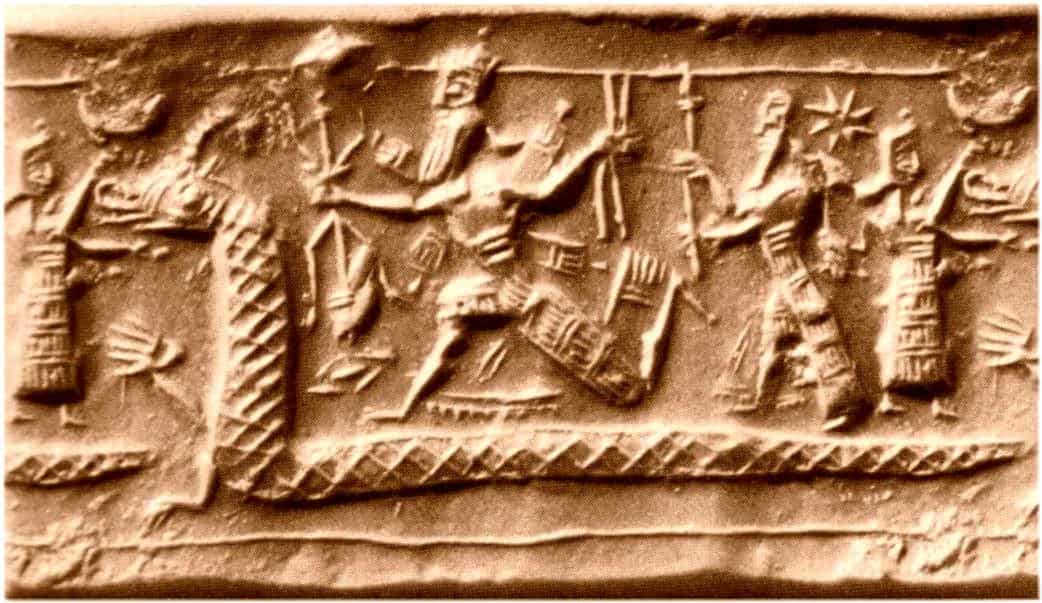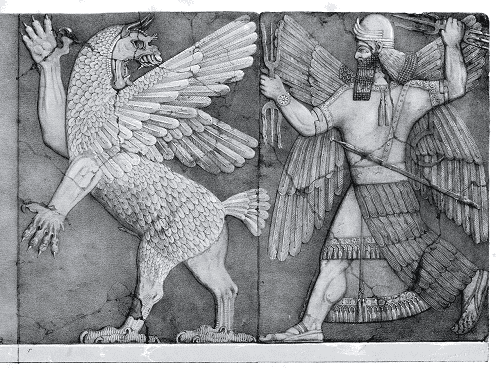This is a new image representation of the face of Lucy, our human ancestor from 3 million years ago, whereas the second image shows a modern blonde female. In 1975, an American scientist named Donald Johanson found a skeleton in Ethiopia. It was of a small female, only about 3.5 feet tall. The skeleton showed that early human ancestors were already walking on two legs around 3 million years ago.
The skeleton was given the name “Lucy,” inspired by the Beatles song “Lucy In The Sky With Diamonds.” She was part of a species called Australopithecus afarensis. Lucy is one of the best-preserved skeletons of early human ancestors that scientists have ever found.

There’s a big conspiracy theory that the shift from Image A to Image B isn’t evolution at all—but genetic manipulation by a more advanced race.
If you are into the controversial stories of Zecharia Sitchin, then according to him, the Anunnaki were intellectually superior beings who shared a wide range of knowledge with the ancient Sumerians, including arithmetic, geometry, calculus, medicine, and metalworking, and taught them writing. Sitchin believed that current Homo Sapiens was the result of genetic manipulation and that the Anunnaki created the Sumerians by mixing the DNA of a hominid with theirs.

The Enuma Elish tells the story of the great god Marduk’s victory over the forces of chaos and his establishment of order at the world’s creation. The story begins like this:
“When in the height heaven was not named,
And the Earth beneath did not yet bear a name,
And the primeval Apsu, who begat them,
And chaos, Tiamut, the mother of them both
Their waters were mingled together,
And no field was formed, no marsh was to be seen;
When of the gods none had been called into being,
And none bore a name, and no destinies were ordained;
Then were created the gods in the midst of heaven,
Lahmu and Lahamu were called into being….”
Note: All creation myth tablets can be found in the Ashur, Kish, and Ashurbanipal libraries at Nineveh. Intriguingly, imprints on the tables indicate copies of much older versions of the narrative that date back to well before the fall of Sumer around 1750 BCE.
According to the cuneiform tablets, human-like gods governed the Earth initially. When they first landed on Earth, they made it habitable by cultivating the soil and extracting the minerals. The passage also mentions the revolution between the gods and their workers.
“When the gods like men
Bore the work and suffered the toll
The toil of the gods was great,
The work was heavy, the distress was.”
It is said that before humans, the Anunnaki (ancient Sumerian, Akkadian, Assyrian, and Babylonian deities) used the Igigi (sometimes also spelled “Igigu”), the young generation of Ancient Astronaut Gods, as their servants to mine gold on Earth. However, when humans rebelled against the Annunaki, the Igigi were replaced by humans.
The ancient Mesopotamians believed that heaven consisted of three domes. The lowest dome of heaven housed the stars, while the intermediate dome housed the Igigi, the younger gods. The farthest and highest dome of heaven was personified as An, the sky god.

In addition, most academics agree that the Igigi are the Sumerian deities of myth. They say the Igigi were servants of the powerful Anunnaki who rose against Enlil, and his regime.
Ancient Origins writes: “Anu, the god of gods, agreed that their labor was too great. His son Enki, or Ea, proposed to create man to bear the labor, and so, with the help of his half-sister Ninki, he did. A god was put to death, and his body and blood were mixed with clay. From that material, the first human being was created, in likeness to the gods.
You have slaughtered a god together
With his personality
I have removed your heavy work
I have imposed your toil on man.
…
In the clay, god and man
Shall be bound,
To a unity brought together;
So that to the end of days
The Flesh and the Soul
Which in a god have ripened –
That soul in a blood-kinship be bound.
This first man was created in Eden, a Sumerian word that means ‘flat terrain.’ In the Epic of Gilgamesh, Eden is mentioned as the garden of the gods, located somewhere in Mesopotamia, between the Tigris and Euphrates rivers.”

According to cuneiform texts, Adapa was the first successful human. The entire species’ lineage was called Adamu. In this instance, the parallels to the Bible are startling. In the 19th century, a tablet was discovered in the ruins of the ancient Babylonian city of Nippur by a team from the University of Pennsylvania. It tells the story of destroying the world through a great flood and an immortal man named Utnapishti, who builds a massive boat to save his family and all types of animals.
This clay tablet is one of the episodes of the epic of creation. It narrates how god Anshar summons the gods together for a banquet. They celebrate god Marduk’s appointment as champion; Marduk defeated Tiamat in the primeval chaos. From the library of Ashurbanipal at Nineveh (modern-day Ninawa Governorate, Iraq), northern Mesopotamia. Neo-Assyrian period, 7th century BCE. (The British Museum, London).
Stanford Professor Dr. Gary Nolan stated in an interview with Event Horizon that Life may have started elsewhere and came here according to some models. He gives examples of atoms of elements present here that actually originated from explosions of other stars/meteorites etc. He states that life in the universe may be based on DNA if the theory of panspermia is correct.
[Interestingly, he is stating this because the verified CIA individual John Ramirez claimed several months ago in an interview that we are related to the ETs and are a result of a genetic manipulation. Luis Elizondo (the official CIA head of the UAP program, currently the contractor for the actual US Space Force) has indicated this thought in his interviews as well, and this ties into his comment that from their understanding, we are part of “mankinds” in plural, multiple forms of humanity present either here, extratemporally (time travelers), or in the cosmos].
According to a study published in 2018, Double Helix, dubbed as i-motif, a new form of DNA was discovered. This paper represents a very early stage of figuring out what the i-motif DNA actually does in human cells. One idea depicts that the i-motif DNA regulates some cell function, as indicated by the fact that it seemed to blink on and off in their observations. (Source)
“We think the coming and going of the i-motifs is a clue to what they do. It seems likely that they are there to help switch genes on or off, and to affect whether a gene is actively read or not,” said Mahdi Zeraati, the lead researcher.
In the same year, scientists published their findings on ‘dark matter’ DNA, which is long, winding strands of DNA with no obvious functions, but it is early identical across all vertebrates, from humans, mice, to chickens. Before, scientists used to think that less than 2 percent of our DNA actually codes for humans, and the rest 98.5 percent of DNA sequences is so-called “junk DNA” that is useless. (Source)
Though science is still evolving and trying to understand the purpose of our DNA, some studies seem to show that intracellular, environmental, and energetic influences can change DNA. In biology, epigenetics is the study of heritable phenotype changes that do not involve alterations in the DNA sequence.
Some researchers suggest we can change our DNA through intention, thoughts, and emotions. Maintaining positive thoughts and effectively overcoming stress can help in getting emotional well-being. It may also maintain our very DNA. On the other hand, a study conducted in 2015 found evidence that depression does not just change our brain, it can also alter our DNA and the way our cells generate energy.
Science Alert wrote: “A team from the Wellcome Trust Centre for Human Genetics investigated the genomes of more than 11,500 women, with the hopes of finding genes that might contribute to the risk of depression. But instead, they stumbled across a signature of metabolic changes in their cells that appears to have been triggered by the disease.
After going back over their results, the researchers also found that the women with stress-related depression had shorter telomeres than the healthy women. Telomeres are the caps at the end of our chromosomes that naturally shorten as we age, and the team began to question whether this process had been sped up by stress.”
According to a Forbes article, “Russian quantum biologist Dr. Vladimir Poponin and his colleague Peter Gariaev through a series of experiments tried to prove that human DNA has a direct effect on the physical world through a field of energy that connects the two. They first recorded the presence of photons in an otherwise empty tube, and noted that the photons were scattered randomly across the tube. Next, they dropped a sample of human DNA in the tube, and found that the photons arranged themselves distinctly in a pattern. Finally, when they removed the DNA from the tube, they expected the photons to go back to being randomly scattered, but to their surprise, they found that the photons remained in a pattern. This behavior of photons in the presence of DNA has come to be known as The DNA Phantom Effect. Other research also points to the strong possibility that human emotions can affect DNA, even at a distance.”
These ideas sound strange to many people, but the reality is often stranger than fiction. Likewise, mainstream scientists and skeptics have long believed the questions of ancient astronaut theorists to be absurd.








